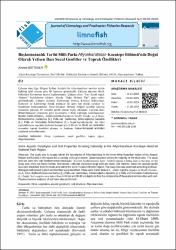| dc.contributor.author | Serteser, Ahmet | |
| dc.date.accessioned | 2019-12-30T14:25:01Z | |
| dc.date.available | 2019-12-30T14:25:01Z | |
| dc.date.issued | 2019 | en_US |
| dc.identifier.citation | SERTESER, A . (2019). Başkomutanlık Tarihi Milli Parkı Afyonkarahisar-Kocatepe Bölümü'nde Doğal Olarak Yetişen Bazı Sucul Geofitler ve Toprak Özellikleri. Journal of Limnology and Freshwater Fisheries Research , 5 (2) , 89-94 . DOI: 10.17216/limnofish.484210 | en_US |
| dc.identifier.uri | http://www.limnofish.org/tr/issue/47894/484210#article_cite | |
| dc.identifier.uri | https://hdl.handle.net/11630/7784 | |
| dc.description.abstract | Çalışma alanı Ege Bölgesi İç-Batı Anadolu’da Afyonkarahisar sınırları içinde bulunup grid sisteme göre B3 karesine girmektedir. Çalışma alanının büyük bölümünü Kuvaterner arazisi kaplamaktadır. Çalışma alanı “Yarı Kurak soğuk Akdeniz” biyoiklimine sahiptir. Alanda “Doğu Akdeniz Tipi” yağış rejimi görülmektedir. Çalışma alanında Kahverengi Orman, Kireçsiz Kahverengi, Koluvyal ve Kahverengi büyük topraklar ile arazi tipi olarak sazlıklar ve bataklıklar bulunmaktadır. Irano-Turanian floristik bölgesi içindeki çalışma alanından yaklaşık 50 vasküler geofit takson teşhis edilmiştir. Çalışma alanı Braun-Blanquet yöntemine göre incelenerek 5 bitki topluluğu tanımlanmıştır. Bunlar: Carex distans L., Carex cuprina (Sándor ex Heuff.) Nendtv. ex A. Kern, Bolboschoenus maritumus (L.) Palla var. maritumus, Schoenoplectus lacustris (L.) Palla ve Scirpoides holoschoenus (L.) Soják’topluluklarıdır. Bu bitki topluluklarının toprakla ilişkisini bulmak için 0-30 cm ve 30-60 cm derinlikler arasından toprak örnekleri alınmış ve bunların fiziksel-kimyasal analizleri yapılarak yorumlanmıştır. | en_US |
| dc.description.abstract | The study area is located within the boundaries of Afyonkarahisar in the Inner-West Anatolian region of the Aegean
Region and located in the square B3 according to the grid system. Quaternary land covers the majority of the study area. The study
area has Semi-dry cold Mediterranean bioclimate. ”Eastern Mediterranean Type” rainfall regime is being seen in the area. In the
study area, there are brown forests, lime brown, colluvial and brown large soils and reeds, and marshes. About 50 vascular geofit
taxa were identified from the study area within the Irano-Turanian floristic region. The study area was examined according to BraunBlanquet method and 5 plant communities were identified. These were Carex distans L., Carex cuprina (Sándor ex Heuff.) Nendtv.
ex A. Kern, Bolboschoenus maritumus (L.) Palla var. maritumus, Schoenoplectus lacustris (L.) Palla and Scirpoides holoschoenus
(L.) Soják. Soil samples were taken from 0-30 cm and 30-60 cm depths to find the relationship of these plant communities with soil.
Physicochemical analyzes of soil were also performed. | en_US |
| dc.description.sponsorship | AKÜ BAPK: 18.KARİYER.86 | en_US |
| dc.language.iso | tur | en_US |
| dc.identifier.doi | DOI:10.17216/LimnoFish.484210 | en_US |
| dc.rights | info:eu-repo/semantics/openAccess | en_US |
| dc.subject | Flora | en_US |
| dc.subject | Vegetation | en_US |
| dc.subject | Aquatic Geophytes | en_US |
| dc.subject | Soil Structure | en_US |
| dc.subject | Afyonkarahisar | en_US |
| dc.title | Başkomutanlık Tarihi Milli Parkı Afyonkarahisar-Kocatepe Bölümü' nde doğal olarak yetişen bazı sucul geofitler ve toprak özellikleri | en_US |
| dc.title.alternative | Some aquatic geophytes and soil properties growing naturally in the Afyonkarahisar-Kocatepe Historial National Park Region | en_US |
| dc.type | article | en_US |
| dc.relation.journal | Limnofish | en_US |
| dc.department | Fen-Edebiyat Fakültesi | en_US |
| dc.authorid | 0000-0003-2792-7239 | en_US |
| dc.identifier.volume | 5 | en_US |
| dc.identifier.startpage | 89 | en_US |
| dc.identifier.endpage | 94 | en_US |
| dc.identifier.issue | 2 | en_US |
| dc.relation.publicationcategory | Makale - Uluslararası - Editör Denetimli Dergi | en_US |
| dc.relation.ec | AKÜ BAPK: 18.KARİYER.86 | |
| dc.contributor.institutionauthor | Serteser, Ahmet | |



















